
KERNOW IS BEAUTIFUL

PORTHLEVEN'S FAMOUS CLOCK TOWER
The Cove of St.Leven...or Porthleven in the Winter Storms this year of February 2014.(The Lizard Peninsula the most southerly point in Kernow is out of view but to the right of the picture,the village is to the left.)The constant winds and high tides from the south and southwest hammered the Porthleven coastline and Harbour.
A recent study of the impact of the waves using seismometres showed impacts equivalent to small earthquakes!
The pier is actually hidden from view and the bar was reduced and rebuilt by the sea and reduced again,each time by metres in height.The bar of course is made up of Cretaceous Flint/and local Porthleven Cornish Metasediments and Igneous Devonian Rocks. The sand bar built by the sea between the sea on the south side and the brackish water Loe or Lake, on the otherside.The high percentage of Flint in the bar comes from a source far away by long shore drift currents,the nearest land based Flint being found at Beer to the east of Cornwall.
The word Loe is similar to the Gaelic word Loch. Nearby Helston was a port with access to the sea before the bar was formed.
King Arthur's Sword is supposed to have be thrown in the Loe,when Arthur died but it is possible to see the Chough flying in this area as they have been nesting on the cliffs to the west at Trewavas and in the old Wheal Trewavas Engine house and on the cliffs of the Lizard on the other southern side of Porthleven.
Cornish people maintain that King Arthur's spirit lives on in An Balores,( The Chough) and that is why Arthur returns to Cornwall when the Chough comes back and why the Chough is the National Emblem of Kernow.
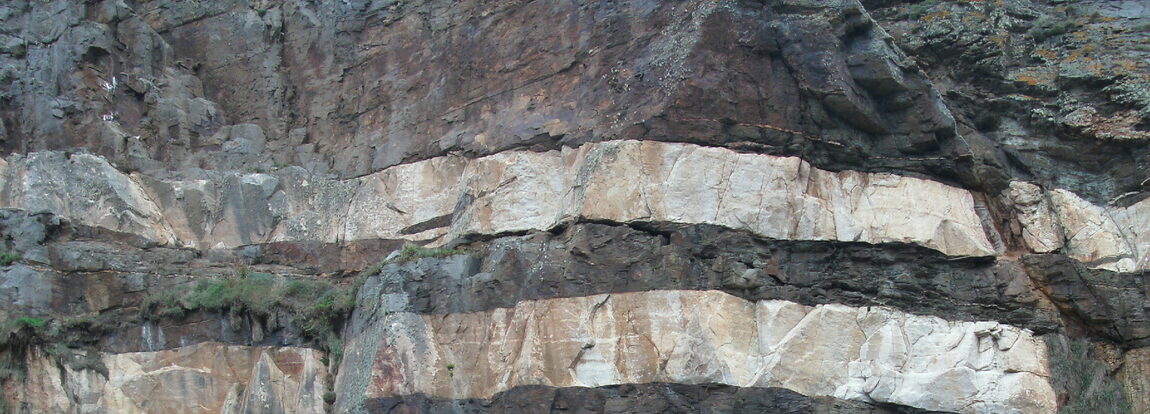
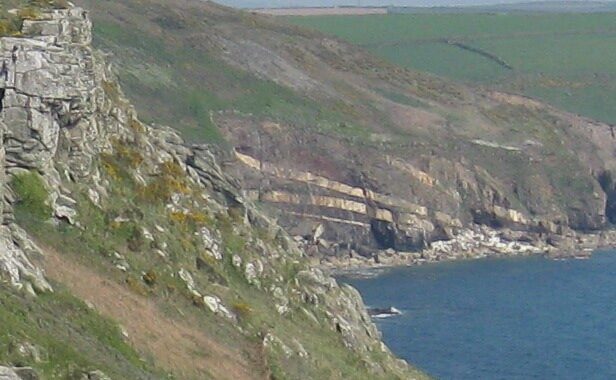
Cliff exposures of the Tremearne Pegmatite South of St.Breage and South West of Porthleven
The Granite Pegmatite exposures here are spectacular and provide a good study resource.Plenty of exposures to photograph and view,similar to those here.
This is a site of special scientific interest.
The light colored rocks above are the plutonic pegmatite intrusions and sills which penetrated and widened bedding planes and weaknesses in the much older darker Devonian Sediments.These Devonian sediments were muds and fine argillaceous sediments which were metamorphosed into Metasediments.The Cornish often call these changed rocks Killas.
The Granite cliff on the immediate left hand side of the photo above shows the blocky nature of the jointing.This provides the foundations for the magnificent Engine House of Wheal Trewavas the shaft of which is visibly going straight down under the sea. The water now rises and falls with the tide in the shaft.The engine house can be viewed from the coastal footpath and shows the skills of the men who built it and installed the heavy Steam pumping and winding engines therein.
If you are lucky then you will see and hear the Cornish Chough which is nesting along this section of coast.Also another rarity,the Peregrine Falcon-unfortunately a brood of Choughs were lost to the Falcon some years ago.But they have successfully bred since.
The Cornish people named this Trewavas after the Tre-farmstead of the Gwavas- winter pastures.There was evidently a system of winter and summer pasturing of their animals with Winter and Summer Farms in Celtic times.

A view showing the large rounded beach bolders of pale granitic pegmatites and rounded black metasediments,(metamorphosed sediments and mudstones) and the sills of granite of varying thickness following the original sedimentary bedding planes.Sometimes the granitic magmas transgressed from one bedding plane to another along faults and weaknesses between the bedding.

WHEAL TREWAVAS AT DUSK.
A picture showing the precareous winding and pumping houses of Wheal Trewavas with the last of the light showing a westerly weather front heading eastwards.
An open shaft on the seaward side of the nearest house provided access to Copper Lodes which allowed mining below the Sea.
CORNWALL IS BEAUTIFUL WHERE EVER YOU GO BUT LOOK WHAT'S ON OUR DOORSTEP!

This the view from all our front windows and rear garden at An Golowjy and An Golowjy Vean,( 5 Coastguards,Porthleven.)
A picture of the outer harbour showing Mounts Bay and Lamorna towards the Land's End in the west.You will see the lighthouses at night flashing their warnings to shipping in the western approaches to the Channel and Celtic Sea.
The life boat house in the near distance is now an art gallery and you can see a small second World War Gun post to the right.Above is the main road to the coastal footpath going towards Gravesend and the coastline towards Tremeane and Wheal Trewavas and St.Michael's Mount.
The low tide allows a view of the modern wave cut platform in darkened grey just below the Gartul Flag post on the point.
Glacial Erratics from previous Glacial periods can be found along this stretch of coastline,carried by icebergs breaking off from the Ice fronts from those glaciers that covered what was to become the Irish Sea and Celtic Sea areas,and farther northern localities as well.As soon as these ice bergs reached warmer waters they melted and dumped their rocky passengers on what became today's Cornish Coast.
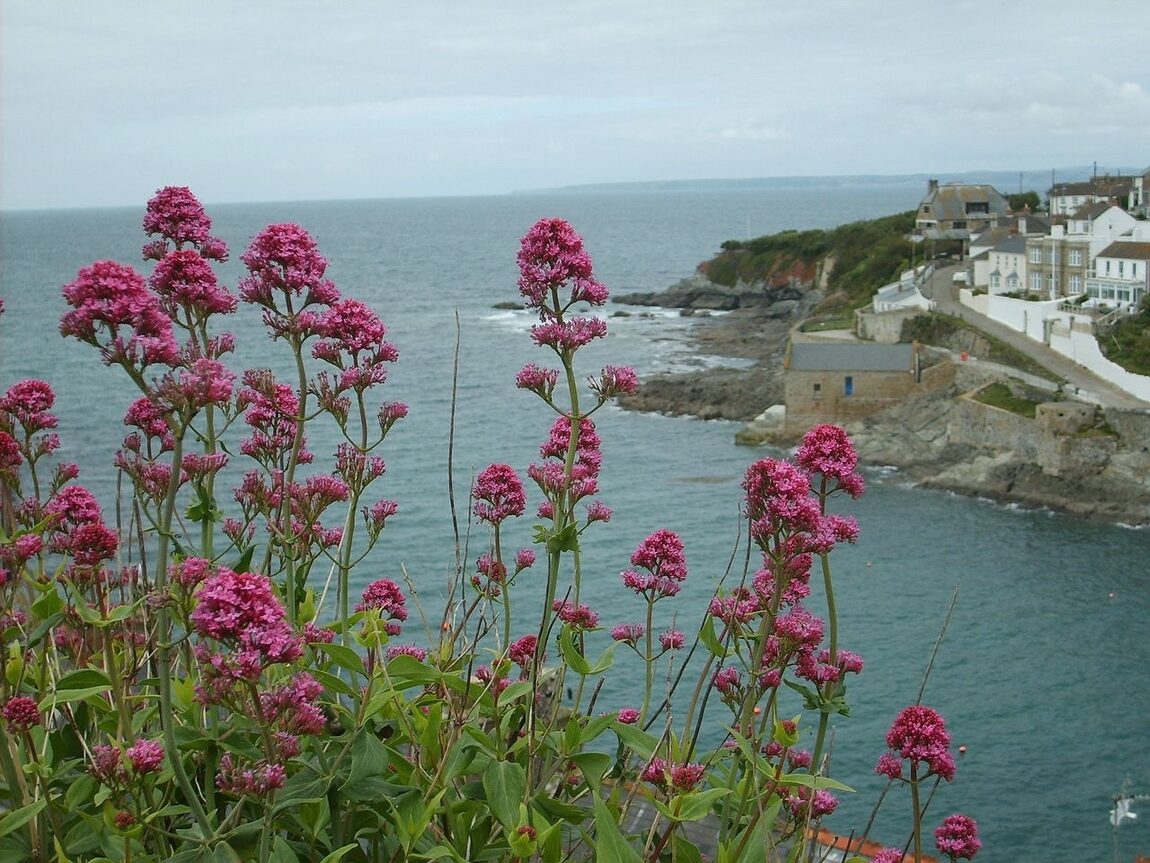 Porthleven above in the Summer with the Valerian flowering on our front garden hedge at An Golowjy ha Golowjy Vean.
Porthleven above in the Summer with the Valerian flowering on our front garden hedge at An Golowjy ha Golowjy Vean.
The headland in the far distance is across Mount's Bay,(St.Michael's Mount and the Town Clock are both out of site.
The foreshore shows the modern wave cut platform-and glacial erratics can be found along the coast deposited by icebergs when the ice melted from the last Ice Age that covered the north,it is thought that they came around the Land's End from Glaciers which covered what is now Ireland,the Irish Sea and the Celtic Sea.
One large erratic in particular is of interest because it is rich in Microcline and Garnet minerals and is like no other rock that has been located or discovered in Ireland or Britain. Did it come from Iceland ?
Porthleven is thus situated between the Land's End in the west and the Lizard in the South of Kernow.
We have named our main cottage Golowjy which is Cornish for An Gowlowjy -The Lighthouse.
This cottage is no.5 Coastguards Cottage and also has a smaller flat An Golowjy Vean.
All the windows on the frontage have views similar to that which shows the seas behind the Valerian.
At time of writing,(May ) the Valerian has started to grow well this year after our severe coastal storms and is preparing to flower again.
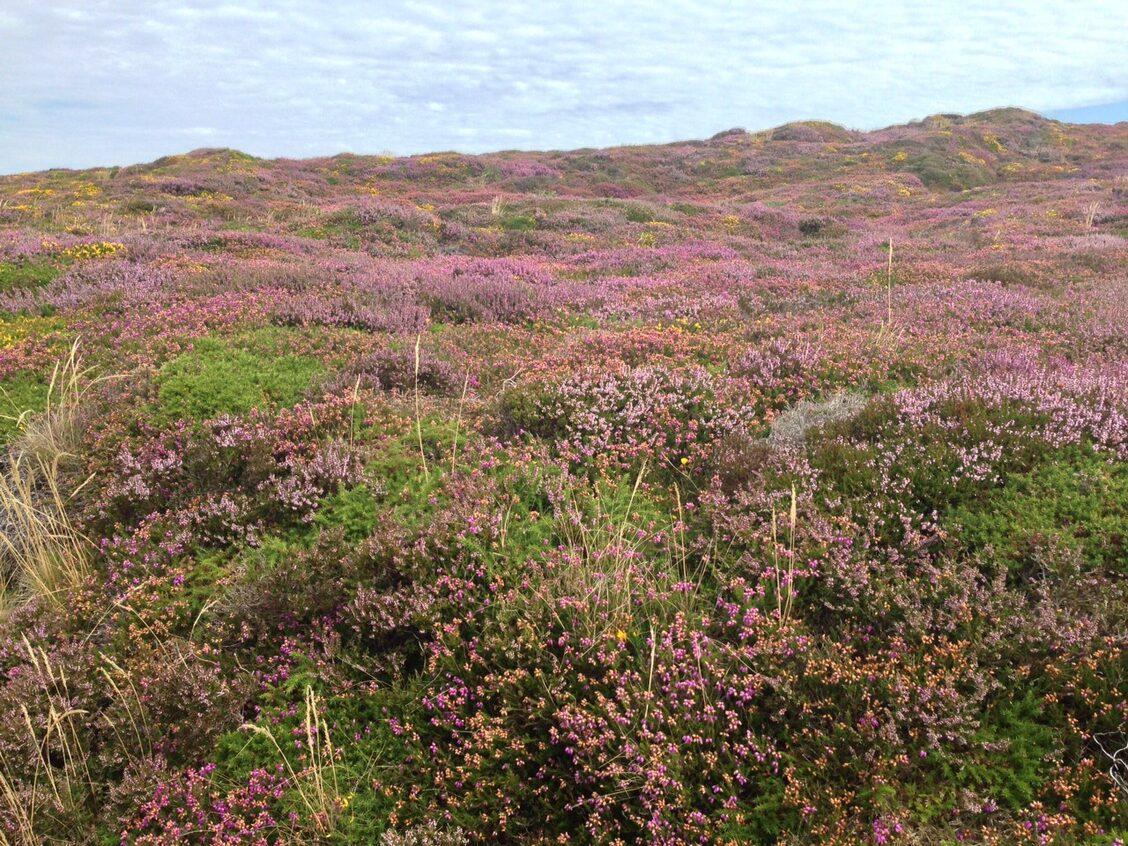
GODREVY LIGHTHOUSE.
Above,the coastal footpath showing Godrevy on the north coast.And below the same coastal area but showing Godrevy Lighthouse.

Cornish Heather in full bloom on the coastal footpath at Godrevy on the north coast of the Country The little section of sea on the top right hand side is part of the Celtic Sea.Soils are thin here and the area is very exposed but highly suitable for the heathers to flourish.
KERNOW IS BEAUTIFUL.
This is Godrevy on the North Coast and shows the Cornish Heather blooming wonderfully.The thin soils and exposure is obviously suitable for the Heather which in turn support healthy bee and insect populations and likewise insect eating birds such as the Chough.The sea here is part of the Celtic Sea and the island with Godrevy Lighthouse and coastal areas are the favourite haunt of seals which inhabit the beaches and caves to give birth to their pups.
FURTHER TO THE WEST IN OUR WEST COUNTRY A VIEW OF THE CROWNS ENGINE HOUSE AT BOTALLACK MINE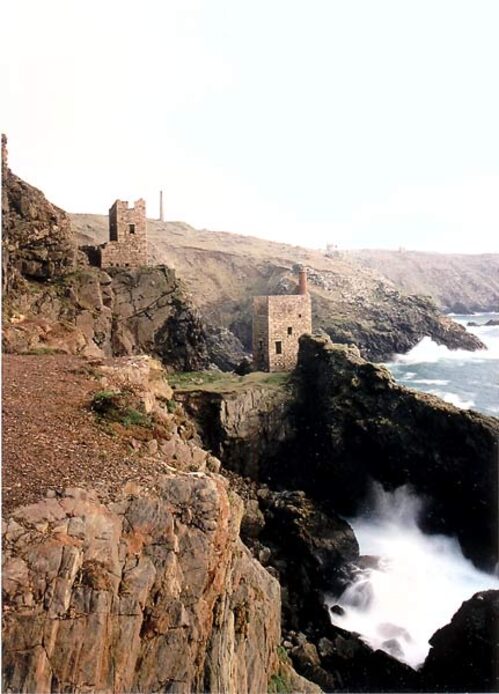
AND LOOKING FURTHER WEST TO THE LAND'S END.
LAST OF THE LIGHT IN A CORNISH SUNSET.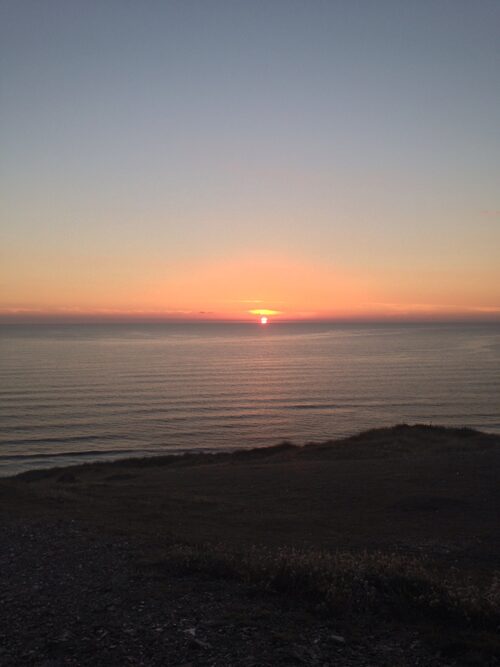
DEW GENES,KERNOW BYS VYKEN!
